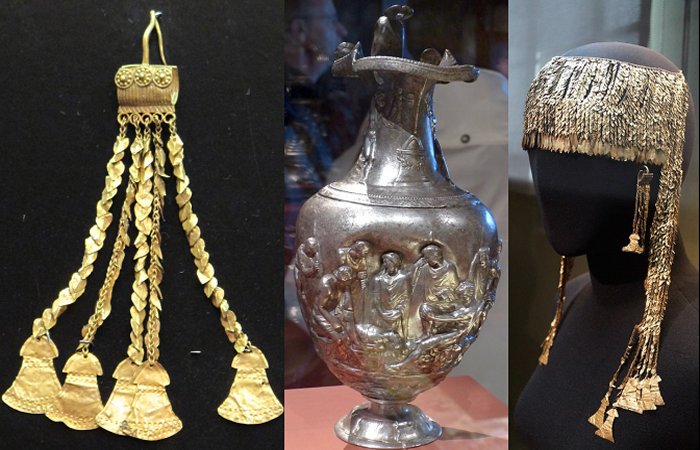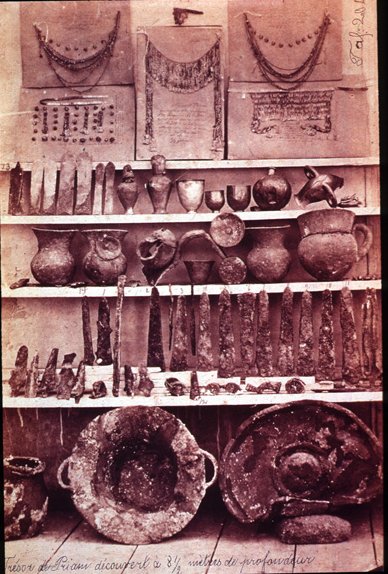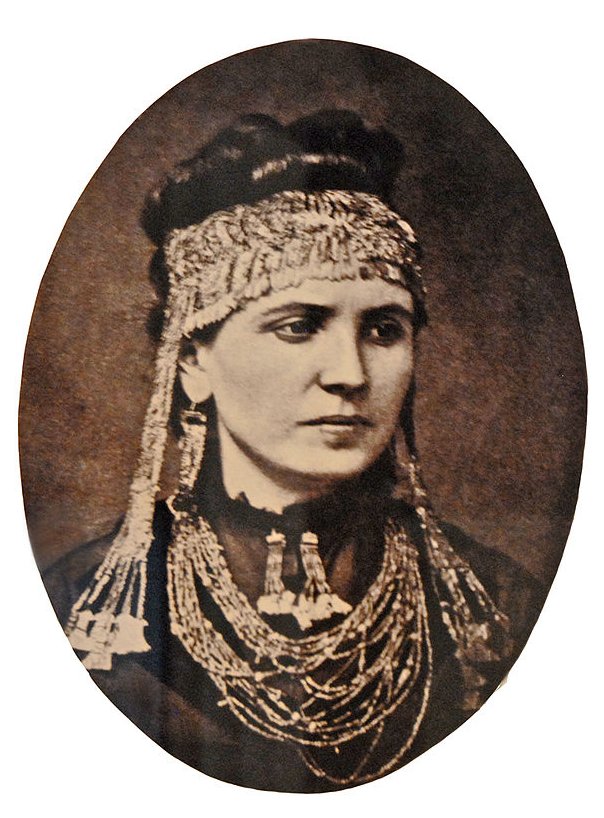Jan Bartek – AncientPages.com – The ancient mystery of Priam’s Treasure remains unsolved. Anyone who appreciates magnificent ancient treasures will be fascinated with the famous Trojan hoard, but are the artifacts authentic?

Some of the Priam treasures – earrings, vase and a big diadem. Credit: sailko – CC BY-SA 3.0 – Finoskov – CC BY-SA 4.0 – NearEMPTiness – CC BY-SA 4.0
This magnificent find remains the largest and most controversial ever made at Troy, and experts are still debating whether Priam’s Treasure is genuine.
Between 1871 and 1873, archaeologist Heinrich Schliemann excavated at the ancient site of Troy in modern-day Turkey. He unearthed ruins of ancient cities that he declared the city of Troy, mentioned in the Iliad, an ancient Greek epic poem attributed to Homer.
The 4,000-year-old ancient city of Troy is nowadays one of the most famous archaeological sites in the world.
Located in what today is known as Anatolia in modern Turkey, the ancient city of Troy was the setting of the Greco-Trojan War that is the subject of Homer’s epic legendary poem The Iliad. However, whether the Trojan War occurred at this spot and whether the site in northwest Turkey is the same as Troy is debatable.
Excited to have found ancient ruins, Schliemann continued digging despite not having permission from the Ottoman government or the landowner. Then, he suddenly announced he had discovered a magnificent trove of beautiful gold, silver, and copper objects. Among them were bracelets, goblets, daggers, shields, and vases, to mention a few.
In his archaeological report, Schielmann stated: “In excavating this wall further and directly by the side of the palace of King Priam, I came upon a large copper article of the most remarkable form, which attracted my attention all the more as I thought I saw gold behind it. …
In order to withdraw the treasure from the greed of my workmen, and to save it for archaeology, … I immediately had lunch break called.
While the men were eating and resting, I cut out the Treasure with a large knife.

Part of Priam’s treasure. Credit: Public Domain
It would, however, have been impossible for me to have removed the treasure without the help of my dear wife, who stood by me ready to pack the things which I cut out in her shawl and to carry them away.”
He called the unearthed artifacts Priam’s Treasure and smuggled the discovered artifacts out of Anatolia.
Schliemann got in real trouble when the Ottoman government learned his wife Sophie had carried one of the jewels, showing the public her husband’s archaeological discovery. The Ottoman government revoked Schliemann’s permission to dig and sued him for its share of the gold. But Schliemann, who had previously been a businessman, found a way to save his archaeological carrier. He offered the Ottoman government some of the Priam’s treasures in exchange for permission to continue excavations at Troy.
There are several reasons why modern scientists question the authenticity of Schliemann’s trove.
According to experts, “Priam’s Treasure has come under suspicion partly because Schliemann’s initial account of the discovery, in his diary, is rather sketchy. It is suggested that at the time it was written, the treasure was not yet complete.” 1
Active Emeritus of Classics David Traill at UC Davis, has thoroughly investigated Schliemann’s discovery of the trove and calls it a fraud.

Schliemann’s wife Sophie wearing the Priam jewels. Credit: Jean-Pierre Dalbéra – CC BY 2.0
Traill says “that it was not a single find as Schliemann represents, but an artificial collection put together from several different sources. The collection formed around a group of bronzes (not identified exactly, but presumably including some of the spearhead, daggers, and falt axes) which was genuinely found on the site of Troy near the end of the 1873 season, but whose precise findspot and date of discovery Schliemann falsified.
To this were added more valuable items which Schliemann had been setting aside from his excavations for just such purpose over a period of months “or even years.” 2
Many researchers still wonder whether Schliemann falsified his discoveries. A study of his background reveals that “Schliemann is known to have been less than completely honest. Schliemann started out as a businessman, and Professors William Calder and David Traill have established that, for example, a banking operation which he ran in California in 1851 was almost certainly shady.; that he lied to secure his U.S. citizenship and divorce in 1868; and that in his publications he exaggerated the degree to which the excavation of Troy had been his life ambition. They conclude that he was a liar.” 1
After being lost for a long time, the Priam artifacts are spread across multiple museums today. Some objects are kept at the Pushkin Museum in Moscow, Russia, while the rest can be seen at the Neues Museum in Berlin, Germany, and Istanbul Archaeology Museum, Istanbul, Turkey.
Scholars will undoubtedly keep debating the authenticity of these ancient treasures for a long. Still, those who want to admire ancient art can visit the mentioned museums and see the objects that have caused such controversy among academics.
Written by Jan Bartek – AncientPages.com Staff Writer
Updated on January 17, 2024
Copyright © AncientPages.com All rights reserved. This material may not be published, broadcast, rewritten or redistributed in whole or part without the express written permission of AncientPages.com
Expand for references
- Easton, D. F. “Heinrich Schliemann: Hero or Fraud?” The Classical World91, no. 5 (1998): 335-43.
- Easton, D. F. “Priam’s Treasure.” Anatolian Studies34 (1984): 141-69.
- David A. Traill – Schliemann of Troy: Treasure and Deceit





